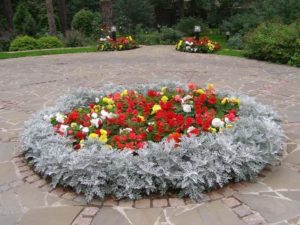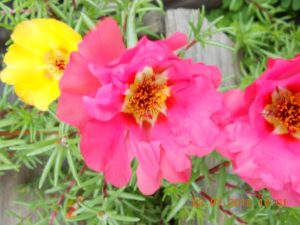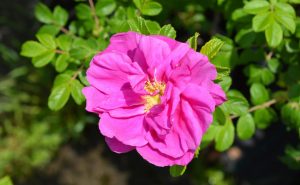
Calluna is a creeping perennial shrub of the heather family and the only representative of its species. It has about 20 ornamental varieties for garden cultivation.
Calluna is low (30-70 cm), but extremely decorative. Its small fragrant flowers, like small bells, are collected in inflorescences, enveloping bushy stems in an air cloud. Very decorative and leaves, as if rolled into a tube (therefore, until the heather blooms, it is often confused with juniper). Blooming calluna begins at the end of summer. The healing honey plant is especially beautiful after the first frosts, when its leaves turn yellow and purple. Frozen inflorescences do not fall off and stay on the bushes for a long time, giving them an exquisitely decorative look. In landscape design, calluna is usually planted next to dwarf hjoynik, along garden paths, in curbs or on alpine hills.

The long existence of calluna on badlands has developed in him a symbiosis with protozoa mushrooms, which help heather roots extract nutrients from poor soils. The Calluna root system is literally enmeshed with mushroom threads, and the mushrooms themselves feed on the vital force of the heather, therefore this unique plant practically does not need fertilizers.
Soil Features for Calluna
Calluna loves sour poorly fertilized and loose soils. Prefers open sunny places, in extreme cases – partial shade. When planting calluna, keep in mind that it absolutely does not tolerate lime and alkaline soils. An ideal soil substrate for it: peat mixed with sand, coniferous soil and sawdust in a ratio of 3: 1: 1: 1. Coniferous land taken from a depth of 5-6 cm from spruce or pine forest. And if you manage to get high-moor peat, then you do not need to add sand to the soil mixture. At 1 cu. m of soil is useful to add 70-80 g of sulfur.
From the place intended for landing of calluna, on 1 bayonet of a shovel, remove the top ground and replace it with a soil mixture. Then lightly crush the soil, walking along it in small steps, and pour it over with a little acidic water.
Landing calluna
Calluna can be planted both in spring and in winter. But it is preferable in the spring, then the heather will have time to take root and perfectly survive the winter frosts. For him, there are several ways of planting: seedlings, seeds, layering, dividing the bush and tip cuttings.
Landing calluna layering
The layering calluna can also multiply independently. Over time, its main trunk and old branches lodge and root themselves, giving life to numerous overgrowths, so the landing of calluna in the country should be artificially limited to a small fence or other structure. And if you want to help your beloved honey plant, sprinkle mature shoots with peat 1-2 cm and fix in the soil. A year after the powder, you will receive a ready seedling, which should be separated from the mother bush and planted in a separate hole.
Planting calluna seedlings
Planting holes organize at a distance of 40-50 cm from each other, and their size is 2 times larger than the root ball. When placing the seedlings, note that the heather roots grow horizontally, but in containers with seedlings purchased in the nursery, they are crowded to the center. Therefore, before planting a calluna, straighten its roots as gently as possible. Drop the seedling to the level of the root collar. After planting, lightly tamp the soil with your hands, pour abundantly and grind the base of the seedling with peat or sawdust. If the soil in your area is clay, pour drainage (pebble, crushed stone, broken brick) to a height of 2-3 cm into each planting hole.
Planting calluna seeds
Calluna can be planted and seeds, but it is quite a long process. First, the seeds are placed in plates, scattering thin (2-3 mm layer), moistened and covered with a glass bowl. After 2-3 weeks, the seeds will germinate, and then they are sown in wooden boxes with a soil substrate, the composition of which is written above. Seedlings usually appear a month after planting. Temperature conditions for its full development: 18-20 ° С. Do not forget to maintain moderate soil moisture in the boxes. In the summer period, the boxes of seedlings are periodically taken out to the open air for hardening. Seedlings of the cabin will be ready for planting in open ground only after 1.5-2 years.
Planting calluna apical cuttings
And if at your dacha decorative honey plant grows already, it is quite possible to propagate it with tip cuttings. At the end of the summer, cut the cuttings from the strongest branches of the bush (do not take flowering shoots). Root the cuttings in separate pots filled with peat mixed with sand (3: 1). Maintain an indoor temperature of 15–18 ° C. Every 2-3 weeks feed the cuttings with a solution of urea: 1 g per liter of water and micronutrient fertilizers. During the wintering season, the cuttings will root well, and in spring they can be planted in open ground.
Planting calluna by rhizome division
This is the easiest and fastest method of landing calluna. At the end of summer, the calluna is dug out, and the root, without shaking it off the ground, is cut into pieces so that each has a young growth, the old stems are cut. Then the root of the young planted in a separate hole.
Calluna care
If you want to have thick calluna plantations, then in early spring moderately prune the upper branches of the shrub. In addition, in the fall, after flowering, the branches of calluna should be cut 5-7 cm below the flowering inflorescences, and the pruning should be left for winter as a shelter. In the spring they should be removed.
Garden honey is fed with mineral fertilizer at the rate of 30-40 g per 1 sq. M. m, once a season. Water as needed. Remove weeds, thus conducting a natural loosening of the soil.
If the winters in your region are harsh, you can cover the calluna for the winter by first adding a mulch layer under each bush: sawdust, peat, dry leaves, etc. In favorable conditions, it grows freely and can live up to 50 years.
Calluna varieties
Calluna vulgaris Alba Plena
Alba Plena is a vertically growing shrub, 30-50 cm tall, with small inflorescences of white double flowers.

Calluna vulgaris Alexandra
Alexandra is a low shrub (20-30 cm), richly covered with inflorescences with pinkish-purple flowers in the frame of dark green leaves.

Calluna vulgaris Gold Haze
Gold Haze – medium growing (40-60 cm) extraordinarily ornamental shrub with snow-white inflorescences of bell-shaped flowers framed in lemon-colored leaves.





Leave a Reply